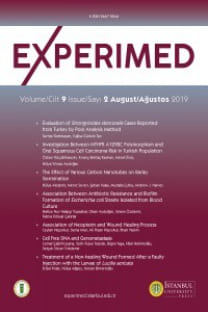Farklı Karbon Nanotüplerin Arpa Çimlenmesi Üzerindeki Etkileri
Tek ve çok tabakalı karbon nanotüpler, karboksillenmiş karbon nanotüpler, arpa, biyomedikal uygulama
The Effect of Various Carbon Nanotubes on Barley Germination
Single- and multi-walled carbon nanotubes, carboxylated carbon nanotubes, barley, biomedical applications,
___
- 1. Kohli P, Martin CR. Smart nanotubes for biotechnology. Curr Pharm Biotechnol 2005, 6: 35-47. [CrossRef] 2. Martin CR, Mitchell DT. Nanomaterials in analytical chemistry. Anal Chem 1998, 70: 322-7. [CrossRef] 3. Martin CR. Nanomaterials - A membrane-based synthetic approach. Science 1994, 266: 1961-6. [CrossRef] 4. Murthy N, Thng YX, Schuck S, Xu MC, Frechet JMJ. A novel strategy for encapsulation and release of proteins: hydrogels and microgels with acid-labile acetal cross-linkers. J Am Chem Soc 2002, 124: 12398-9. [CrossRef] 5. Kim SJ, Lewis B, Steiner MS, Bissa UV, Dose C, Frank JA. Superparamagnetic iron oxide nanoparticles for direct labeling of stem cells and in vivo MRI tracking. Contrast Media Mol Imaging 2016; 11: 55-64. [CrossRef] 6. Cruz-Acuña M, Halman JR, Afonin KA, Dobson J, Rinaldi C. Magnetic nanoparticles loaded with functional RNA nanoparticles. Nanoscale 2018. 10: 17761-70. [CrossRef] 7. Lee SB, Mitchell DT, Trofin L, Nevanen TK, Söderlund H, Martin CR. Antibody-based bio/nanotube membranes for enantiomeric drug separations. Science 2002. 296: 2198-200. [CrossRef] 8. Martinelli V, Cellot G, Toma FM, Long CS, Caldwell JH, Zentilin L, et al. Carbon nanotubes promote growth and spontaneous electrical activity in cultured cardiac myocytes. Nano Lett 2012; 12: 1831-8. [CrossRef] 9. Lahiani MH, Dervishi E, Chen J, Nima Z, Gaume A, Biris AS, et al. Impact of carbon nanotube exposure to seeds of valuable crops. ACS Appl Mater Interfaces 2013; 5: 7965-973. [CrossRef] 10. Mukherjee A, Majumdar S, Servin AD, Pagano L, Dhankher OP, White JC. Carbon Nanomaterials in Agriculture: A Critical Review. Front Plant Sci 2016; 7: 172. [CrossRef] 11. Wang X, Liu Z. Carbon nanotubes in biology and medicine: An overview. Chinese Sci Bull 2012; 57: 167-80. [CrossRef] 12. Daniel S, Rao T, Rao K, Rani SU, Naidu GRK, Lee HY, et al. A review of DNA functionalized/grafted carbon nanotubes and their characterization. Sensor Actuat B-Chem 2007; 122: 672-82. [CrossRef] 13. Welsher K, Liu Z, Daranciang D, Dai H. Selective probing and imaging of cells with single walled carbon nanotubes as near-infrared fluorescent molecules. Nano Lett 2008, 8: 586-590. [CrossRef] 14. Veetil JV, Ye K. Tailored carbon nanotubes for tissue engineering applications. Biotechnol Prog 2009; 25: 709-21. [CrossRef] 15. De La Torre-Roche R, Hawthorne J, Deng Y, Xing B, Cai W, Newman LA, et al. Multiwalled carbon nanotubes and C60 fullerenes differentially impact the accumulation of weathered pesticides in four Agricultural plants. Environ Sci Technol 2013; 47: 12539-47. [CrossRef] 16. Serag MF, Kaji N, Gaillard C, Okamoto Y, Terasaka K, Jabasini M, et al. Trafficking and subcellular localization of multiwalled carbon nanotubes in plant cells. ACS Nano 2011, 5: 493-9. [CrossRef] 17. Pandey K, Lahiani MH, Hicks VK, Hudson MK, Green MJ, Khodakovskaya M. Effects of carbon-based nanomaterials on seed germination, biomass accumulation and salt stress response of bioenergy crops. PLoS One 2018; 13: doi: 10.1371/journal.pone.0202274. [CrossRef] 18. Stampoulis D, Sinha SK, White JC. Assay-dependent phytotoxicity of nanoparticles to plants. Environ Sci Technol 2009; 43: 9473-9. [CrossRef] 19. Hao Y, Ma C, Zhang Z, Song Y, Weidong Cao W, Jing Guo J et al. Carbon nanomaterials alter plant physiology and soil bacterial community composition in a rice-soil-bacterial ecosystem. Environ Pollut 2018; 232: 123-36. [CrossRef] 20. Marascuilo LA, McSweeney M. Post-Hoc Multiple Comparisons in sample preparations for test of homogenesity. In: McSweeney M, Marascuilo L A (Eds) Non-Parametric and Distribution Free Methods the Social Science,. Books/Cole Publication, Belmont CA, 1977. p. 141-7. 21. Liu P, Wang X, Li H. Preparation of carboxylated carbon nanotubes/polypyrrole composite hollow microspheres via chemical oxidative interfacial polymerization and their electrochemical performance. Synthetic Metals 2013; 181: 72-8. [CrossRef] 22. Liu HK, Wang GX, Guo Z, Wang J, Konstantinov K. Nanomaterials for lithium-ion rechargeable batteries. J Nanosci Nanotechnol 2006, 6: 1-15. [CrossRef] 23. Khodakovskaya MV, de Silva K, Biris AS, Dervishi E, Villagarcia H. Carbon nanotubes induce growth enhancement of tobacco cells. ACS Nano 2012, 6: 2128-35. [CrossRef] 24. Wu Z, Mitra S. Fractionation of carboxylated carbon nanotubes and the corresponding variation in their colloidal behaviour. Environ Sci Process Impacts 2014; 16: 2295-300. [CrossRef] 25. Liu Z, Liu Y, Peng D. Carboxylation of multiwalled carbon nanotube attenuated the cytotoxicity by limiting the oxidative stress initiated cell membrane integrity damage, cell cycle arresment, and death receptor mediated apoptotic pathway. J Biomed Mater Res A 2015; 103: 2770-7. [CrossRef] 26. Lin D, Xing B. Phytotoxicity of nano particles: inhibition of seed germination and root growth. Environ Pollut 2007; 150: 243-50. [CrossRef] 27. Tripathi S, Sarkar S. 2014. Influence of water soluble carbon dots on the growth of wheat plant. Appl Nanosci 2015; 5: 609-16. [CrossRef] 28. Sonkar SK, Roy M, Babar DG, Sarkar S. Water soluble carbon nano-onions from wood wool as growth promoters for gram plants. Nanoscale 2012, 4: 7670-5. [CrossRef] 29. Lahiani MH, Chen J, Irin F, Puretzky AA, Green MJ, Khodakovskaya MV. Interaction of carbon nano horns with plants: uptake and biological effects. Carbon 2015; 81: 607-19. [CrossRef] 30. Anjum NA, Singh N, Singh MK, Sayeed I, Duarte AC, Pereira E, et al. Single-bilayer graphene oxide sheet impacts and underlying potential mechanism assessment in germinating faba bean (Vicia faba L.). Sci Total Environ 2014; 472: 834-41. [CrossRef]
- Yayın Aralığı: Yılda 3 Sayı
- Başlangıç: 2011
- Yayıncı: İstanbul Üniversitesi
Özlem KÜÇÜKHÜSEYİN, Kıvanç Bektaş KAYHAN, Meral ÜNÜR, Hülya YILMAZ AYDOĞAN
Neopterin ve Yara İyileşme Süreci İlişkisi
Ceylan HEPOKUR, Sema MISIR, Ali İhsan HEPOKUR, İlhan YAYLIM
Serhat SİREKBASAN, Tuğba GÜRKÖK TAN
Hatice Nur HALİPÇİ TOPSAKAL, Okan AYDOĞAN, Sinem ÖZDEMİR, Fatma KÖKSAL ÇAKIRLAR
Farklı Karbon Nanotüplerin Arpa Çimlenmesi Üzerindeki Etkileri
Hülya AKDEMİR, Merve SEVEN, Şaban KALAY, Mustafa ÇULHA, Andrew J. HARVEY
Hücre Dışı DNA ve Genometastaz
Cemal Çağıl KOÇANA, Selin Fulya TOPRAK, Büşra YAŞA, Hilal HEKİMOĞLU, Selçuk Sözer TOKDEMİR
Hatalı Enjeksiyon Sonucu Oluşan ve İyileşmeyen Yaranın Lucilia sericata’nın Larvaları ile Tedavisi
